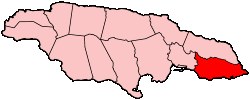
Population: 91,900
Capital: Morant Bay
Major Towns: Port Morant, Yallahs, Seaforth, Golden Grove, Bath

St. Thomas lies in the southeastern corner of Jamaica, covering an area of 742.8 square kilometers (286.8 square miles). This parish is notably mountainous, with prominent ranges such as the Port Royal Mountains extending from above Newcastle in St. Andrew to Albion in St. Thomas. The Queensbury Ridge spans between the Yallahs and Negro Rivers, while Yallahs Hill, an isolated ridge in the south, peaks at 2,394 feet above sea level.
The coastal area, stretching between Yallahs and Hector's River, features extensive wetlands including Cow Bay Swamp, Albion Swamp, and the Great Morass. The coastline is marked by cliffs and sandy or gravelly beaches.
The three main rivers are:
The parish boasts one of Jamaica's two famous spas, located in Bath.
St. Thomas is rich in natural resources, with high-grade deposits of gypsum and marble, and occurrences of talc and asbestos near Bath. Vegetation ranges from dry limestone scrub forest below 1,250 feet to lush mountain forests at higher elevations.
The origin of the name St. Thomas is uncertain. The area was densely populated by the Tainos/Arawaks when Columbus arrived. Spaniards established cattle ranches at Morant Bay and Yallahs. After the English captured Jamaica, they invited residents from other British colonies to settle here. Only the people of Nevis accepted the invitation. Tragically, two-thirds of the 1,600 settlers, including Governor Stokes and his wife, died from fevers, though their surviving children built the impressive Stokes Hall and Stokesfield, whose ruins still stand.
In 1674, French Admiral Du Casse attacked Morant Bay, killing many settlers and taking slaves. The local militia, reinforced by troops from Spanish Town, eventually repelled the invaders. Later, Maroons settled in the mountains of St. Thomas and joined forces with the Maroons in Portland to form the Windward Maroons.
The Morant Bay Rebellion of 1865 marked a significant chapter in Jamaica's history. Discontent among ex-slaves over land tenure issues led Paul Bogle to lead a delegation to Governor Eyre in Spanish Town. Denied an audience, Bogle and his followers later marched to a vestry meeting at the Morant Bay Courthouse. Confrontations escalated, leading to the killing of several people and the burning of the courthouse. George William Gordon, who supported Bogle, was tried for conspiracy and hanged. Bogle was captured and also hanged.
The brutal reprisals resulted in over 430 deaths and the destruction of more than 1,000 homes. Public outcry led to a Royal Commission investigation, the recall of Governor Eyre, and Jamaica's transition to a Crown Colony. In 1969, Paul Bogle and George William Gordon were named National Heroes.
In the late 19th and early 20th centuries, St. Thomas thrived on banana exports, with Port Morant and Bowden as key shipping points. Today, St. Thomas Sugar Co. operates one of Jamaica's eight remaining sugar factories. Eastern Banana Estates, Serge Island Dairies, and various coconut plantations contribute to the parish's agricultural output. The parish's proximity to Kingston has spurred development, attracting investment from returning residents.
Agriculture: Key exports include sugar, bananas, and coconuts. Small farmers also produce domestic and orchard crops, contributing significantly to employment.
Dairy Production: Led by Serge Island Dairies.
Manufacturing: Focuses on food processing and electrical equipment.
St. Thomas continues to evolve, blending its rich history with modern development and agriculture, making it a unique and significant part of Jamaica.